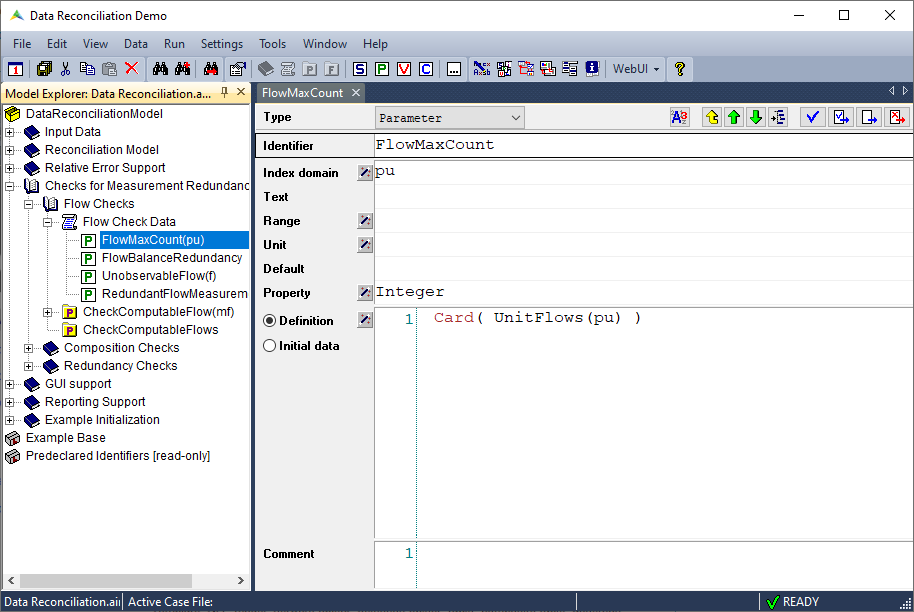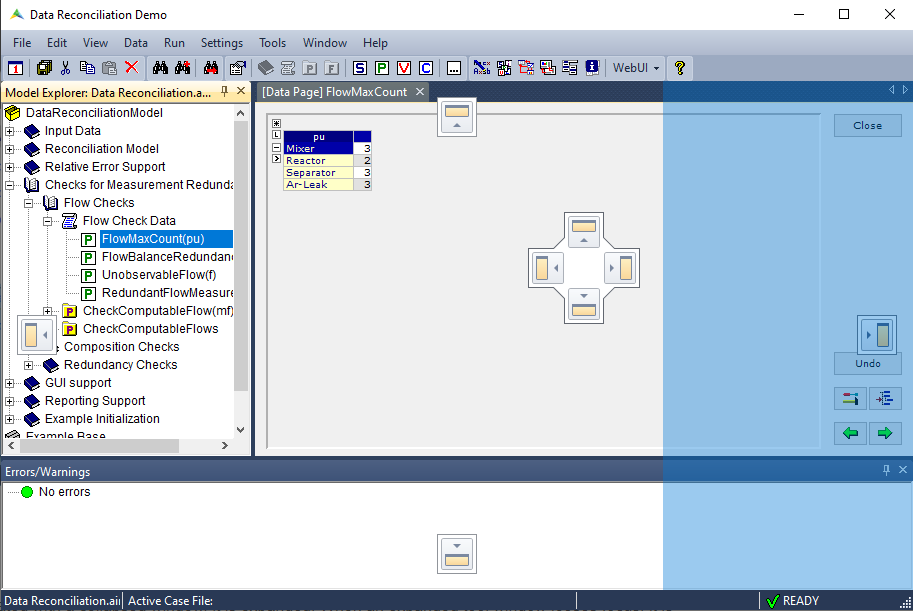Dockable windows
Support for dockable windows
Dockable windows are an ideal means to keep frequently used tool windows in an development environment permanently visible, and are a common part of modern Integrated Development Environments (IDE) such as Visual Studio .NET.
Docking states
Dockable windows can be used in a docked, auto-hidden, or floating state. Whether a dockable window is in a docked, auto-hidden or floating state can be changed at runtime through drag-and-drop.
Docked windows
When docked, the tool windows are attached to the left, right, top or bottom edge of the client area of the main AIMMS window. By default, all modeling tools discussed in Modeling tools are docked at the left edge of the AIMMS window, as illustrated in Fig. 4.

Fig. 4 Example of a Model Explorer docked at the left edge
Tool windows persistence
AIMMS automatically stores the location and size of each tool window. This information is used to restore the location and size of each tool window whenever an AIMMS session is started.
Dragging windows
By dragging the windows caption of a docked window and moving the cursor around the edges of the AIMMS window, you can move the docked window to another position. While hovering over a drop target, a blue rectangle (as illustrated in Figure Fig. 5) snaps into place at the appropriate location, whenever a dockable window is ready to be docked at the location corresponding to the drop target. The area of a docked window can also be split into two by dragging another dockable window into the upper, lower, left or right part of docked window. In all these cases, a blue rectangle shows how a dockable window will be docked when you release the mouse at that time.

Fig. 5 Drag-and-drop windows
Auto-hidden windows
In auto-hidden state, a dockable window is normally collapsed as a
button to the upper, lower, left or right edge of the main AIMMS window.
When you push the button associated with a collapsed window, it is
expanded. When an expanded tool window looses focus, it is collapsed
again. By clicking the pushpin button  in the caption of a
docked/collapsed window, you can change the window’s state from docked
to auto-hide and back.
in the caption of a
docked/collapsed window, you can change the window’s state from docked
to auto-hide and back.
Floating tool windows
By dragging a tool window away from an edge of the main AIMMS window, it becomes floating. When AIMMS is the active application, floating tool windows are always visible on top of all other (non-floating) AIMMS windows. Floating windows can also be shown outside the main AIMMS window frame.
Tabbed MDI mode
By default, all pages and attribute forms are shown in tabbed MDI mode. In Fig. 4 the main page of the application is displayed in tabbed MDI mode, with the attribute windows of two identifiers in the model accessible through tabs. Tabbed MDI windows occupy the remaining space of the client area of the main AIMMS window that is not occupied by docked windows. This implies that you do not have control over the size of tabbed MDI windows. Therefore, if you use tabbed MDI mode in your AIMMS application, it makes sense to make all the pages in your model resizable. However, the display mode of a page can be changed to docked (by checking the Allow User Dockable option on the Page Properties dialog box). This would for example allow you to turn a page into a floating window and display it on you second monitor.
Tab groups
When you drag the tab associated with a document window in the document window area, you can move the document window into a new or existing tab group, at the left, right, top or bottom of the current tab group. Tab groups effectively split the document window area into multiple parts, each of which can hold one ore more tabbed MDI windows. As with dragging dockable windows, a drag rectangle shows where the window will be positioned if you drop it at that moment. Tab groups are very convenient, for instance, if you want to view two attribute windows simultaneously.